AI-Enhanced Blockchain for Scalable IoT-Based Supply Chain
Abstract
1. Introduction
- Research Gap and Contribution: This study addresses the gap in integrating artificial intelligence (AI) with blockchain technology to optimize performance in IoT-based supply chains. Existing research often overlooks the synergy between AI and blockchain, particularly in overcoming the specific challenges of latency, scalability, and data management. By proposing the ABISChain platform, this research introduces a novel approach that combines AI with blockchain to enhance supply chain efficiency. This approach not only addresses existing limitations, but also contributes to the theoretical understanding of AI-enabled blockchain systems.
- Scientific Discipline and Novelty: The present research contributes to the field of supply chain management and blockchain technology by presenting a new system model that leverages AI to optimize blockchain performance. The ABISChain platform represents a significant advancement in integrating AI with blockchain, offering improved scalability, data consistency, and security. This study also extends the application of AI in blockchain environments, providing a deeper understanding of how AI can enhance decentralized systems.
- Increased Cognitive Value: This research expands the analysis of blockchain and AI integration within supply chains, offering a comprehensive review of the existing literature and identifying gaps in current solutions. Through incorporating AI-driven optimization techniques, the study enhances the cognitive value of supply chain management research and provides a robust platform for future advancements.
- Methodology: We conducted a systematic review of the literature by searching major databases with keywords related to the IoT, blockchain, and AI in supply chain management. Relevant articles were selected based on their contribution to understanding the integration of these technologies and addressing supply chain challenges.
2. Overview of AI, Blockchain, and IoT-Based Supply Chains
2.1. Supply Chain Challenges
2.2. Blockchain
2.3. Artificial Intelligence
2.4. Blockchain-Based Supply Chain
- Decentralization: Blockchain technology creates a distributed system with no central administrator and establishes its own rules based on a consensus mechanism. In a supply chain based on blockchain, the participants in the blockchain are able to identify any data deterioration [31]. For this reason, blockchain technology solves the issues related to centralization, hacking, data integrity, and corruption and increases data validity [30].
- Trustworthiness: The core feature of the blockchain is a completely unified vision of subscribers’ information that is always available. In cryptography systems, the privacy of the user’s online accounts, as well as their anonymity, is enabled [32]. Each user in the blockchain sees the same information and cannot modify or remove it. Blockchain’s decentralized nature makes trust unavoidable for data records in a decentralized supply chain. One study proposed that supply chain transparency must be a primary feature of blockchain to promote trust among food companies [33].
2.5. Blockchain-Based Supply Chain Challenges
2.6. Ideal Supply Chain Requirements
2.7. Summary
3. Related Work: A Critical Literature Review
3.1. Blockchain-Based Supply Chains
- Shipchain [48] is an integrated supply chain system that focuses on tracing shipments among their transportation cycle. Shipchain is a smart contract and side-chain platform that runs on the Ethereum public blockchain. For cost-cutting purposes, all records are saved on Ethereum, whereas side chain data are maintained and confirmed on the concerned parties’ network. As a result, data are stored either on Ethereum or on side chains without the use of an intermediary. Shipchain also includes a web platform allowing shippers to interact with carriers instead than using traditional brokerage arrangements.
- Devery [49] is an Ethereum verification technology. It is employed to create checking apps in which vendors should provide a unique identifier of their products. The identifiers are kept on Ethereum and are used to validate an item during application searches. This protocol is made up of structures communicating with Ethereum using smart contracts. StructApp, unique identifier, and account are the three types of data structures. Product information, brand accounts, and app accounts are all contained in the Struct product. The unique identification for each product kept on the blockchain is determined via the hash of the product information.
- Cargox [50] is a decentralized system that uses the Ethereum blockchain to handle bill of lading papers. Cargox is a global leader in supply chain logistics trade. Users communicate over the Cargox DApp’s API interface and generate their smart bills of lading. Users can consume CXO tokens or exchange them to dollars to make payments.
- CargoCoin [51] is a supply chain platform based on Ethereum that intends to regroup all cargoes in a single platform and connect them to the designated counterparties. Within the blockchain, both the smart contracts and the service’s platform are used to achieve this goal. Many communication channels are provided in this platform for CargoCoin actors participating in the supply chain’s evolution, including sending/receiving, approving, rejecting, and signing documents.
- WaltonChain [52] is a supply chain blockchain that allows many participants to track RFID-based transactions. It is made up of a main chain and sub-chains, with the mainchain hosting and mining the WTC coin. Following construction and registration within the main chain, a sub-chain runs independently. Significant information about the sub-chains is stored in the main chain. Sub-chains have their own ledgers while still being part of the main chain network. POW, POS, and POL are used to form parent chain consensus. Because the main chain works independently of sub-chains, the size of its ledger is unaffected by the number of sub-chains. As a result, the main chain is scalable and secure.
- OriginTrail [53] combines several partner apps, blockchain, and off-chain solutions. It employs a variety of participants. ODN (OriginTrail Decentralized Network) is the name for the off-chain network. As a result, the solution is made up of blockchain platform apps, the ODN, and concerned parties’ apps.
- All manufacturers who utilize the VeChain [54] platform provide unique identifiers to their products. VeChain Identity (VID) technology is used to create these IDs. A SHA256 hash algorithm is used to produce each VID. This VID is saved in the blockchain, while it is embedded in the product through an NFC chip, RFID tag, or QR code. As a result, both retailers and customers may trace the product’s journey using this method. It is based on the Ethereum source and has been forked and upgraded. The main improvements of VeChain are as follows: To begin with, the format of the transaction consists of an identifier, Blockref, Expiration, and DependsOn. As every transaction has its unique identifier, the app only needs to deal with a single transaction. Blockref in VeChain provides further data about the current, previous, and future blocks and information about transaction creation. The expiration feature is utilized to avoid stacking over an extended period. VeChain supports the multi-task transaction concept to handle complicated business payments, and each transaction is made up of numerous small transactions. Proof of authority (POA) is the consensus mechanism used by VeChain. This mechanism incorporates both stake and reputation.
- Modum [55] is a supply chain management system which manages the delivery of large quantities of fragile items, particularly pharmaceuticals. It consists of a Modum temperature logger sensor, Ethereum, and API apps. The frontend and backend parts of the Modum architecture are separated. Ethereum smart contracts and a dedicated server connecting external users constitute the backend. The frontend consists of mobile apps and sensors that communicate with backend server through the REST API and JSON. Tags are the most valuable added value, as they are used to assess the environmental conditions of shipments.
- The Bext360 [56] technology employs a blockchain-based system to track agricultural goods at any level of the supply chain. Bext360 offers traceability as well as payment and smart contract management. It is built on a RESTful API that supply chain actors can use to integrate the solution to their apps and websites.
- The decentralized application WaBI [57] establishes a safe interface between participants. It is a standalone blockchain that is placed on a user’s smartphone and used to verify their merchandise via a phone app. WaBI offers a mining mechanism which rewards users for their participation. The incentive procedure takes place during the scanning process, in which each scan is completed with a proof of purchase. Tokens in this solution are used to safeguard the registered goods.
- To achieve successful farm-to-table food traceability, the TE-FOOD [58] solution proposes a single ecosystem which includes all manufacturing parties (production, transportation, and so on). Food corruption and untrustworthy supply networks are combated by TE-FOOD. It includes the TFD utility token as well as blockchain technology, smart contracts, and RFID identification technologies. The procedure involves two types of blockchain: Ethereum (public blockchain), which was adopted for the payment procedure using TE-FOOD tokens, and a private blockchain for recording these transactions.
- FarmaTrust [59] is a reliable cloud-based technology that offers a means of tracing pharmaceutical items via a supply chain. To improve scalability, it is built on Ethereum and uses proof of authority as a consensus mechanism. Both Cassandra and MongoDB represent the database layer. In this solution, the API and blockchain layers are separated.
- Agrichain [60] is a decentralized network for the agriculture supply chain that uses the Ethereum blockchain. The three major levels of Agrichain are private, public blockchains, and apps. The public blockchain stores the basic Agrichain data, transactions, and smart contracts. Shoppers use a private Agrichain to minimize fees and waiting periods. The Agrichain platform’s application layer controls the blockchains.
- Blockverify [31] is a blockchain-based anti-counterfeiting solution for premium supply chain products. Blockverify is a hybrid of blockchain that sequentially stores information in public (Bitcoin) and permissioned blockchains. In this approach, a product is supervised and has its own specific tag; with this tag, clients can determine the transparency level of the product since its creation.
- Chronicled [61] uses “tamper-proof cryptographic stamp” identification to trace tangible objects and record them on the blockchain using smart tags and the Chronicledapplication. A Smart Tag is a cryptographically secure chip containing information on a physical product and is connected to a private key.
- Everledger [62] is a company that uses two blockchain systems to preserve the quality of diamond articles. Rather of scaling up the system, it employs Hyperledger (private) and Ethereum (public) blockchains to assure the immutability of the transaction history.
- Leteane et al. [63] proposed a framework solution combining blockchain technology with a multi-trust, package-based trust model to address the trustworthiness issues in food supply chain traceability. This solution leverages the immutable and transparent nature of blockchain to ensure data integrity, preventing any actor in the supply chain from tampering with records. The integration of the trust model enhances the system by identifying specific areas in the supply chain where quality and safety issues arise. This combination of blockchain for data security and the trust model for transparency and accountability results in a more reliable and adaptable system that strengthens trust among supply chain actors and end consumers.
- The Agri-4-All [64] framework integrates blockchain, smart contracts, and the IoT to transform agricultural food supply chains by automating and digitizing both intra-organizational and inter-organizational processes. By utilizing business process modeling and the Reference Architecture for Modeling Industry 4.0, this framework monitors the health and environment of agricultural products in real time throughout the supply chain. The implementation of hybrid smart contracts using Ganache and Truffle suite significantly reduces gas costs, improving transaction efficiency. While the framework provides transparency and security, future work will focus on addressing interoperability challenges between different blockchains and improving privacy protection for stakeholders.
- A proposed distributed application [65] for the traceability of table olives on the Ethereum blockchain demonstrates the potential of blockchain technology in enhancing traceability, transparency, and food safety. By providing a secure, transparent, and efficient solution for tracking table olives from producer to consumer, the application improves the reliability of supply chain data, reduces processing time, and helps producers comply with international standards. The study also highlights the importance of integrating disruptive technologies like the IoT for real-time monitoring and suggests future research to address scalability, interoperability, and cost challenges.
- Petratos et al. [66] explore the impact of fake news, misinformation, and disinformation on supply chain disruptions and propose blockchain as a solution to manage information risks. They developed a theoretical framework that considers these types of misleading information in supply chain risk management and supply chain resilience. Their paper suggests strategies to mitigate disruptions caused by low-quality information by leveraging blockchain, such as using blockchain’s transparency and immutability to enhance risk management and resilience. Blockchain also promotes cooperation and information sharing among supply chain participants, improving overall risk management. While the framework presents a theoretical solution, future research is needed to empirically validate blockchain’s effectiveness and explore its integration with other Industry 4.0 technologies for more robust supply chain risk management.
- A blockchain-enabled healthcare supply chain management [67] approach was proposed to enhance the efficiency and performance of healthcare supply chains, especially in the wake of the COVID-19 pandemic. The solution integrates blockchain technology to create a more sustainable healthcare supply chain, focusing on improving stakeholder involvement and sustainable healthcare supply chain practices. By utilizing blockchain’s secure, transparent, and immutable data recording capabilities, the system enhances trust among stakeholders while optimizing the flow of medical supplies and services. This approach also facilitates real-time tracking of healthcare goods, ensuring the quality and timely delivery of medical supplies. Through the adoption of blockchain, the healthcare supply chain becomes more resilient, helping to combat the challenges posed by the pandemic. The data analysis performed in this study shows that blockchain adoption positively affects the overall performance of healthcare supply chain practices, providing a robust framework for future implementations in healthcare logistics.
3.2. Existing Blockchain Solutions and Techniques That Can Satisfy Supply Chain Requirements
3.2.1. AI-Based Blockchain “NeuroChain”
3.2.2. Pruning
- Reduced storage requirements: Pruning the state, meaning removing unnecessary data from the blockchain, significantly reduces storage requirements for nodes, enabling a broader spectrum of devices to participate in the network.
- High performance: Through strategically removing unnecessary data from the blockchain, the network can operate faster and with lower resource requirements, leading to improved overall performance.
- Reduced synchronization time: Reducing the blockchain state size allows new nodes to synchronize with the latest state much faster, lowering the barrier to entry for joining the network and contributing to the consensus process.
- Reduced transaction fees: As the blockchain state grows, verifying transactions requires more computational power and storage space. This strain on the network can lead to congestion, slowing down processing times and driving up transaction fees. Pruning can dramatically speed up transactions, potentially leading to very low fees.
3.3. Summary
4. ABISChain: System Model, Design, and Implementation
4.1. System Model
ABISChain Blockchain Concepts
- Agents: An agent refers to a software entity capable of autonomous decision-making and interaction within the network. Agents operate independently, making their own decisions based on their beliefs, desires, and intentions [80]. The BDI algorithm is a well-established framework used in multi-agent systems [81]. It models an agent’s decision-making process by considering its beliefs (the agent itself, other agents (data), and its environment like the blockchain, pruned blockchain, and blockchain network), desires (the agent’s goals like generating blocks and pruning the blockchain), and intentions (the chosen desires and its impact on ABISChain). After the BDI algorithm is integrated into the pruned blockchain architecture, each agent can analyze its beliefs about the state of the blockchain network, evaluate its desires and goals, and form intentions to participate in specific blockchain activities such as creating or proposing new blocks. There are two different agent types (light agent and full agent):
- Light agent: The light agent holds only the pruned blockchain and considers it as its current belief according to the environment state to decide which action to perform.
- Full agent: In contrast to light agents, full agents consider the entire blockchain as their belief according to the environment state.
- Consensus and Validation: As highlighted by Baliga [82], a blockchain-based system is as secure and robust as its consensus model. The consensus mechanism not only ensures that all participants in the network agree on the validity of transactions but also plays a critical role in securing the blockchain against malicious attacks and ensuring its scalability. In our ABISChain blockchain, the consensus is achieved through a voting process where agents participate in electing a representative agent responsible for creating the new block. This approach not only decentralizes decision-making but also allows for pruning the blockchain when necessary, which optimizes storage and enhances the overall efficiency of the system. The combination of a robust voting-based consensus mechanism and strategic pruning ensures that ABISChain remains both secure and scalable, adapting dynamically to the needs of the network.
- Data Pruning Mechanism: The mechanism analyzes the usage of data and determines which information is frequently accessed or modified. By considering the relevance and frequency of data usage, the system prioritizes the availability of such data by providing it to all agents.
- Usage Tracking: Data usage is tracked within the blockchain network via the agent caching system. Tracking the usage helps to identify the most frequently accessed or modified data.
- Pruning Algorithm: The algorithm analyzes the usage data and determines which information should be pruned. This algorithm should consider factors like recency, frequency, and relevance of data usage. Based on these parameters, the algorithm can determine which data should be retained and which can be pruned from the blockchain.
- Data Retrieval: Users can easily retrieve pruned data if needed. A light node is allowed to retrieve the required pruned data from a full agent. Zheng et al. [83] discuss the importance of efficient data retrieval mechanisms to ensure that data remain accessible when required.
- APIs: APIs allow supply chain users to interact with the ABISChain blockchain system, retrieve relevant data, and access the most recent information. Prusty [84] highlights the role of APIs in facilitating user interaction with blockchain systems, ensuring seamless data access and retrieval.
4.2. Design and Implementation
- User submits data: The user provides the data that they want to add to the ABISChain blockchain. These data can be in any format or structure depending on the requirements of the blockchain; in our platform, we use JSON objects Figure 4.
- Connection to an ABISChain agent: The user’s data needs to be submitted to an agent that is connected to the ABISChain network. An agent is a software component responsible for interacting with the blockchain network. The agent can be a node, a specialized application, or a service provided by a third party.
- Agent adds data to the mempool: The ABISChain agent receives the data from the user and adds the data to its mempool. The mempool, short for memory pool, is a storage area where pending transactions or data are temporarily held before they are included in a block and added to the blockchain.
- Broadcasting to other network agents as shown in Figure 5: After adding the data to its mempool, the ABISChain agent broadcasts this information to other agents in the ABISChain network. Broadcasting means sending the data to all the connected agents in a peer-to-peer manner so that they are aware of the pending data.
- Each agent obtains the number of connections of other agents. This represents the number of agents that an agent is connected to in the ABISChain network.
- The agent obtains the ABISChain block headers. Block headers typically contain metadata about the blocks in the blockchain, such as the previous block hash, timestamp, and other relevant information like the block value.
- The agent generates its vote of other agents using the formula: *ABV(AgentBlocksValue)This formula takes into account the block value, the number of connections the agent has, and adds 1 to the total. The block value is calculated based on the type of data associated with the block. In our system, we use three types of data: health, finance, and information technology. These types have different weights: 3 for health, 2 for finance, and 1 for information technology. The block value is calculated based on the type of data that will be added to the block.
- The agent adds its vote to the voting list, which likely consists of the votes from other agents participating in the election process.
- The agent broadcasts its vote to the ABISChain blockchain network, allowing other agents in the network to receive and process the vote.
- The agent begins by pulling the cached data from its caching system. This cached data are typically the information that was previously provided to ABISChain users through ABISChain APIs by the current agent. The caching system stores these data for the pruning list generation phase.
- The agent runs a script that applies Dice’s coefficient to identify the active data. Dice’s coefficient is a similarity measure used to compare two sets of data. By employing this coefficient, the agent can determine which data are considered active or relevant.
- Once the agent generates the list of active data, it adds this list to its pruning lists’ mempool. The pruning list’s mempool serves as a temporary storage location where pending pruning lists are stored before they are used to generate the pruned ABISChain blockchain.
- The agent broadcasts its pruning list to the other agents in the ABISChain network. Through this broadcast, the agent enables other agents to receive and process the shared pruning list.
- A user requests data from an agent through an API. Our platform offers two interfaces for retrieving data from the blockchain: Block Explorer and Blockchain Explorer, as shown in Figure 9. The user specifies the data they require from the ABISChain network.
- The agent receiving the request first checks its cache for the requested data. The cache stores previously retrieved data for faster access.
- If the agent finds the requested data in its cache, it can directly provide the data to the user.
- If the agent does not find the requested data in its cache, its actions depend on whether it is a light node or a full node:
- Light Node: A light node, which typically maintains a pruned version of the blockchain, will search for the requested data in its pruned blockchain. If the data are found, they can be provided to the user. However, if the data are not available in the pruned blockchain, the light node needs to request the data from a full node.
- Full Node: A full node maintains the entire blockchain and has a complete copy of all the data. If the agent is a full node, it will search for the requested data in the entire blockchain.
- In case the agent does not the requested data in its cache, the agent adds the requested data to its cache before providing the data to the user.
- Block Mining Process:
- Triggering the Process: The elected miner initiates the block mining process after a specific time has elapsed since the last mined block or when the size of the mempool data reaches a certain threshold.
- Data Classification: The miner evaluates the data in the mempool using a data classifier. The data classifier employs techniques like n-grams and cosine similarity to classify and categorize the data.
- Block Creation: Based on the evaluation and classification, the miner creates a new block. The block includes a body containing the selected data and a header that comprises information such as the previous block header hash, block hash, creation date, miner’s identity, and data value.
- Broadcasting: Once the new block is created, the miner broadcasts it to the ABISChain network, allowing other agents to receive the block.
- Pruning Process:
- Triggering the Process: The agent launches the pruning process when a certain time has elapsed since the last pruning process or when the current size of the blockchain reaches a specific threshold, as shown in Figure 11.
- Pruning Execution: During the pruning process, the agent selects the best pruning list to optimize the ABISChain blockchain. The pruning list selector is based on the particle swarm optimization algorithm that allows us to obtain the finest pruning list. The specific details of the pruning based on the particle swarm optimization process are explained in detail in our article [85].
- Result Handling: If the pruning process succeeds, a new pruned blockchain is generated. However, if the process fails, indicating unsuccessful pruning by the agent, the previous pruned blockchain is retained.
- Broadcasting: If a new pruned blockchain is generated, the agent broadcasts it to the ABISChain network, enabling other agents to receive and adopt the updated pruned blockchain.
4.3. Summary
5. Experiment and Analysis
5.1. Storage Complexity
- Let represent the size of the entire blockchain.
- Let represent the size of the pruned blockchain.
- Let F denote the number of full nodes.
- Let L denote the number of light nodes.
5.2. Processing Time to Generate Blocks
5.3. Reading Data Time
5.4. Pruning Time
5.5. Pruned ABISChain Evolution over Time
5.6. Comparing ABISChain to Other Blockchains
- Comparison of ABISChain with general blockchains: This includes well-known blockchains like Bitcoin, Litecoin, and Solana, which serve a variety of use cases but are not specifically tailored for supply chain management.
- Comparison of ABISChain with blockchain-based supply chain solutions: This focuses on blockchain platforms developed explicitly for supply chain management, such as VeChain, Devery, and Shipchain, which ABISChain surpasses in terms of data throughput and storage optimization.
5.6.1. Comparison of ABISChain with General Blockchains
5.6.2. Comparison of ABISChain with Blockchain-Based Supply Chain Solutions
6. Conclusions
Author Contributions
Funding
Data Availability Statement
Conflicts of Interest
References
- Jum’a, L.; Ikram, M.; Jose Chiappetta Jabbour, C. Towards circular economy: A IoT enabled framework for circular supply chain integration. Comput. Ind. Eng. 2024, 192, 110194. [Google Scholar] [CrossRef]
- Mishra, D.; Gunasekaran, A.; Childe, S.J.; Papadopoulos, T.; Dubey, R.; Wamba, S.F. Vision, applications and future challenges of Internet of Things: A bibliometric study of the recent literature. Ind. Manag. Data Syst. 2016, 116, 1331–1355. [Google Scholar] [CrossRef]
- Al-Fuqaha, A.; Guizani, M.; Mohammadi, M.; Aledhari, M.; Ayyash, M. Internet of Things: A Survey on Enabling Technologies, Protocols, and Applications. IEEE Commun. Surv. Tutor. 2015, 17, 2347–2376. [Google Scholar] [CrossRef]
- Xu, L.D.; He, W.; Li, S. Internet of Things in Industries: A Survey. IEEE Trans. Ind. Inform. 2014, 10, 2233–2243. [Google Scholar] [CrossRef]
- Chung, C.M.; Chen, C.C.; Shih, W.P.; Lin, T.E.; Yeh, R.J.; Wang, I. Automated machine learning for Internet of Things. In Proceedings of the 2017 IEEE International Conference on Consumer Electronics—Taiwan (ICCE-TW), Taipei, Taiwan, 12–14 June 2017; pp. 295–296. [Google Scholar] [CrossRef]
- Dudczyk, P.; Dunston, J.; Crosby, G. Blockchain Technology for Global Supply Chain Management: A Survey of Applications, Challenges, Opportunities & Implications (March 2024). IEEE Access 2024, 12, 70065–70088. [Google Scholar] [CrossRef]
- Nakamoto, S. Bitcoin: A Peer-to-Peer Electronic Cash System. Available online: https://bitcoin.org/bitcoin.pdf (accessed on 14 April 2023).
- Casino, F.; Dasaklis, T.; Patsakis, C. A systematic literature review of blockchain-based applications: Current status, classification and open issues. Telemat. Inform. 2018, 36, 55–81. [Google Scholar] [CrossRef]
- Kshetri, N. 1 Blockchain’s roles in meeting key supply chain management objectives. Int. J. Inf. Manag. 2018, 39, 80–89. [Google Scholar] [CrossRef]
- Jordan, M.; Mitchell, T. Machine Learning: Trends, Perspectives, and Prospects. Science 2015, 349, 255–260. [Google Scholar] [CrossRef]
- Jeong, Y.S.; Park, J.H. IoT and Smart City Technology: Challenges, Opportunities, and Solutions. J. Inf. Process. Syst. 2019, 15, 233–238. [Google Scholar] [CrossRef]
- Rejeb, A.; Keogh, J.G.; Treiblmaier, H. Leveraging the Internet of Things and Blockchain Technology in Supply Chain Management. Future Internet 2019, 11, 161. [Google Scholar] [CrossRef]
- Saberi, S.; Kouhizadeh, M.; Sarkis, J.; Shen, L. Blockchain technology and its relationships to sustainable supply chain management. Int. J. Prod. Res. 2019, 57, 2117–2135. [Google Scholar] [CrossRef]
- Hsu, C. Service Science: Design for Scaling and Transformation; World Scientific: Singapore, 2009. [Google Scholar] [CrossRef]
- He, L.; Xue, M.; Gu, B. Internet-of-things enabled supply chain planning and coordination with big data services: Certain theoretic implications. J. Manag. Sci. Eng. 2020, 5, 1–22. [Google Scholar] [CrossRef]
- Atzori, L.; Iera, A.; Morabito, G. The Internet of Things: A survey. Comput. Netw. 2010, 54, 2787–2805. [Google Scholar] [CrossRef]
- Liu, L.; Liu, X.; Li, X. Cloud-Based Service Composition Architecture for Internet of Things; Springer: Berlin/Heidelberg, Germany, 2012; pp. 559–564. [Google Scholar] [CrossRef]
- Tzounis, A.; Katsoulas, N.; Bartzanas, T.; Kittas, C. Internet of Things in agriculture, recent advances and future challenges. Biosyst. Eng. 2017, 164, 31–48. [Google Scholar] [CrossRef]
- Lee, I.; Lee, K. The Internet of Things (IoT): Applications, investments, and challenges for enterprises. Bus. Horiz. 2015, 58, 431–440. [Google Scholar] [CrossRef]
- Manyika, J.; Chui, M.; Bisson, P.; Woetzel, J.R.; Dobbs, R.; Bughin, J.; Aharon, D. The Internet of Things: Mapping the Value Beyond the Hype 2015. Available online: https://www.mckinsey.com/~/media/McKinsey/Industries/Technology%20Media%20and%20Telecommunications/High%20Tech/Our%20Insights/The%20Internet%20of%20Things%20The%20value%20of%20digitizing%20the%20physical%20world/Unlocking_the_potential_of_the_Internet_of_Things_Executive_summary.ashx (accessed on 14 April 2023).
- Maersk and IBM Unveil First Industry-Wide Cross-Border Supply Chain Solution on Blockchain. Available online: https://www.prnewswire.com/news-releases/maersk-and-ibm-unveil-first-industry-wide-cross-border-supply-chain-solution-on-blockchain-300418039.html (accessed on 20 March 2023).
- Salah, K.; Rehman, M.H.U.; Nizamuddin, N.; Al-Fuqaha, A. Blockchain for AI: Review and Open Research Challenges. IEEE Access 2019, 7, 10127–10149. [Google Scholar] [CrossRef]
- Chen, D.; Chang, G.; Jin, L.; Ren, X.; Li, J.; Li, F. A Novel Secure Architecture for the Internet of Things. In Proceedings of the 2011 Fifth International Conference on Genetic and Evolutionary Computing, Kitakyushu, Japan, 29 August–1 September 2011; pp. 311–314. [Google Scholar] [CrossRef]
- Dorri, A.; Kanhere, S.S.; Jurdak, R.; Gauravaram, P. Blockchain for IoT security and privacy: The case study of a smart home. In Proceedings of the 2017 IEEE International Conference on Pervasive Computing and Communications Workshops (PerCom Workshops), Kona, HI, USA, 13–17 March 2017; pp. 618–623. [Google Scholar] [CrossRef]
- Gil, D.; Ferrández, A.; Mora-Mora, H.; Peral, J. Internet of Things: A Review of Surveys Based on Context Aware Intelligent Services. Sensors 2016, 16, 1069. [Google Scholar] [CrossRef]
- Mart, D.; Meltzer, R.B. Artificial intelligence—A personal view. Artif. Intell. 1977, 9, 37–48. [Google Scholar] [CrossRef]
- Movafaghi, S.; Pournaghshband, H. Lab Based Curriculum for CIS and Related Technology. arXiv 2018, arXiv:1801.06053. [Google Scholar] [CrossRef]
- Song, M.; Zhong, K.; Zhang, J.; Hu, Y.; Liu, D.; Zhang, W.; Wang, J.; Li, T. In-Situ AI: Towards Autonomous and Incremental Deep Learning for IoT Systems. In Proceedings of the 2018 IEEE International Symposium on High Performance Computer Architecture (HPCA), Vienna, Austria, 24–28 February 2018; pp. 92–103, ISSN 2378-203X. [Google Scholar] [CrossRef]
- Rauchs, M.; Glidden, A.; Gordon, B.; Pieters, G.C.; Recanatini, M.; Rostand, F.; Vagneur, K.; Zhang, B.Z. Distributed Ledger Technology Systems: A Conceptual Framework; Technical Report; SSRN: Rochester, NY, USA, 2018. [Google Scholar] [CrossRef]
- Tian, F. An agri-food supply chain traceability system for China based on RFID amp; blockchain technology. In Proceedings of the 2016 13th International Conference on Service Systems and Service Management (ICSSSM), Kunming, China, 24–26 June 2016; pp. 1–6, ISSN 2161-1904. [Google Scholar] [CrossRef]
- Bocek, T.; Rodrigues, B.B.; Strasser, T.; Stiller, B. Blockchains everywhere—A use-case of blockchains in the pharma supply-chain. In Proceedings of the 2017 IFIP/IEEE Symposium on Integrated Network and Service Management (IM), Lisbon, Portugal, 8–12 May 2017; pp. 772–777. [Google Scholar] [CrossRef]
- Crosby, M. BlockChain Technology: Beyond Bitcoin. Appl. Innov. 2016, 2, 71. [Google Scholar]
- Casey, M.J.; Wong, P. Global Supply Chains Are About to Get Better, Thanks to Blockchain. Harv. Bus. Rev. 2017, 13, 2018. [Google Scholar]
- Jiang, Y.; Wang, C.; Wang, Y.; Gao, L. A Cross-Chain Solution to Integrating Multiple Blockchains for IoT Data Management. Sensors 2019, 19, 2042. [Google Scholar] [CrossRef] [PubMed]
- De Angelis, S.; Aniello, L.; Lombardi, F.; Margheri, A.; Sassone, V. PBFT vs proof-of-authority: Applying the CAP theorem to permissioned blockchain. In Proceedings of the CEUR Workshop Proceedings 2018, Ceske Budejovice, Czech Republic, 1–3 June 2018. [Google Scholar]
- Liang, J.M.; Chen, J.J.; Cheng, H.H.; Tseng, Y.C. An Energy-Efficient Sleep Scheduling with QoS Consideration in 3GPP LTE-Advanced Networks for Internet of Things. IEEE J. Emerg. Sel. Top. Circuits Syst. 2013, 3, 13–22. [Google Scholar] [CrossRef]
- Hang, L.; Kim, D.H. Design and Implementation of an Integrated IoT Blockchain Platform for Sensing Data Integrity. Sensors 2019, 19, 2228. [Google Scholar] [CrossRef]
- Sun, X.; Ansari, N. Dynamic Resource Caching in the IoT Application Layer for Smart Cities. IEEE Internet Things J. 2018, 5, 606–613. [Google Scholar] [CrossRef]
- Wang, X.; Zha, X.; Ni, W.; Liu, R.P.; Guo, Y.J.; Niu, X.; Zheng, K. Survey on blockchain for Internet of Things. Comput. Commun. 2019, 136, 10–29. [Google Scholar] [CrossRef]
- Peters, G.; Panayi, E. Understanding Modern Banking Ledgers Through Blockchain Technologies: Future of Transaction Processing and Smart Contracts on the Internet of Money; Technical Report; SSRN: Rochester, NY, USA, 2015. [Google Scholar] [CrossRef]
- Bocek, T.; Stiller, B. Smart contracts—Blockchains in the wings. In Digital Marketplaces Unleashed; Linnhoff-Popien, C., Schneider, R., Zaddach, M., Eds.; Springer: Berlin/Heidelberg, Germany, 2017; pp. 169–184. [Google Scholar] [CrossRef]
- Kshetri, N. Can Blockchain Strengthen the Internet of Things? IT Prof. 2017, 19, 68–72. [Google Scholar] [CrossRef]
- Banerjee, M.; Lee, J.; Choo, K.K.R. A blockchain future for internet of things security: A position paper. Digit. Commun. Netw. 2018, 4, 149–160. [Google Scholar] [CrossRef]
- Reyna, A.; Martín, C.; Chen, J.; Soler, E.; Díaz, M. On blockchain and its integration with IoT. Challenges and opportunities. Future Gener. Comput. Syst. 2018, 88, 173–190. [Google Scholar] [CrossRef]
- Qian, Y.; Jiang, Y.; Chen, J.; Zhang, Y.; Song, J.; Zhou, M.; Pustišek, M. Towards decentralized IoT security enhancement: A blockchain approach. Comput. Electr. Eng. 2018, 72, 266–273. [Google Scholar] [CrossRef]
- Swan, M. Blockchain thinking: The brain as a DAC (decentralized autonomous organization). Available online: https://www.the-blockchain.com/docs/Blockchain%20Thinking%20-%20The%20Brain%20as%20a%20DAC%20-%20Decentralized%20Autonomous%20Organization.pdf (accessed on 21 March 2023).
- Nikhil, V.; Paolo, T. An Analysis of Blockchain Adoption in Supply Chains Between 2010 and 2020. Front. Blockchain 2021, 4, 610476. [Google Scholar]
- ShipChain. Available online: https://www.scribd.com/document/368730835/shipchain-whitepaper (accessed on 20 March 2023).
- Devery. Available online: https://devery.io/whitepaper/Devery_Whitepaper_rev5.pdf (accessed on 21 March 2023).
- CargoX. Available online: https://www.cargox-holding.com/CargoX-Whitepaper.pdf (accessed on 21 March 2023).
- CargoCoin. Available online: https://thecargocoin.com/docs/CargoCoin-Whitepaper.pdf (accessed on 21 March 2023).
- Waltonchain. Available online: https://github.com/WaltonChain/WhitePaper/blob/master/Waltonchain%20White%20Paper%202.0_EN.pdf (accessed on 21 March 2023).
- Origintrail. Available online: https://origintrail.io/documents/OriginTrail-White-Paper-1.pdf (accessed on 21 March 2023).
- VeChain. Available online: https://www.vechain.org/assets/whitepaper/whitepaper-1-0.pdf (accessed on 21 March 2023).
- Modum. Available online: https://assets.modum.io/wp-content/uploads/2017/08/modum-whitepaper-v.-1.0.pdf (accessed on 21 March 2023).
- Bext360. Available online: https://www.ico.org/documents/cy2017-18/Presentations/bext360_Daniel-Jones.pdf (accessed on 21 March 2023).
- WABI. Available online: https://www.allcryptowhitepapers.com/wabi-whitepaper/ (accessed on 21 March 2023).
- TE-FOOD. Available online: https://te-food.com/wp-content/uploads/2020/11/te-food-white-paper.pdf (accessed on 5 April 2023).
- FarmaTrust. Available online: https://cisfunctionsstorage.blob.core.windows.net/cis-files/whitepaper/FTT_farmatrust.pdf (accessed on 21 March 2023).
- AgriChai. Available online: https://chain.agrindo.net/white-paper/ (accessed on 21 March 2023).
- Chronicled. Available online: https://www.chronicled.com/chronicled-resources-new?content-type=Whitepapers (accessed on 21 March 2023).
- Smits, M.; Hulstijn, J. Blockchain applications and institutional trust. Front. Blockchain 2020, 3. [Google Scholar] [CrossRef]
- Leteane, O.; Ayalew, Y. Improving the Trustworthiness of Traceability Data in Food Supply Chain Using Blockchain and Trust Model. J. Br. Blockchain Assoc. 2024, 7, 1–12. [Google Scholar] [CrossRef] [PubMed]
- Raza, Z.; Haq, I.U.; Muneeb, M. Agri-4-All: A Framework for Blockchain Based Agricultural Food Supply Chains in the Era of Fourth Industrial Revolution. IEEE Access 2023, 11, 29851–29867. [Google Scholar] [CrossRef]
- Kechagias, E.P.; Gayialis, S.P.; Papadopoulos, G.A.; Papoutsis, G. An Ethereum-Based Distributed Application for Enhancing Food Supply Chain Traceability. Foods 2023, 12. [Google Scholar] [CrossRef]
- Petratos, P.N.; Faccia, A. Fake news, misinformation, disinformation and supply chain risks and disruptions: Risk management and resilience using blockchain. Ann. Oper. Res. 2023, 8, 1–28. [Google Scholar] [CrossRef]
- Vishwakarma, A.; Dangayach, G.; Meena, M.; Gupta, D.S.; Luthra, S. Adoption of Blockchain Technology enabled Healthcare Sustainable Supply Chain to improve Healthcare Supply Chain Performance. Manag. Environ. Qual. Int. J. 2022, 34, 1111–1128. [Google Scholar] [CrossRef]
- Ambrosus. Available online: https://www.allcryptowhitepapers.com/wp-content/uploads/2018/05/Ambrosus-AMB-Whitepaper.pdf (accessed on 21 March 2023).
- Kim, S.; Kwon, Y.; Cho, S. A Survey of Scalability Solutions on Blockchain. In Proceedings of the 2018 International Conference on Information and Communication Technology Convergence (ICTC), Jeju, Republic of Korea, 17–19 October 2018; pp. 1204–1207, ISSN 2162-1233. [Google Scholar] [CrossRef]
- NeuroChain. Available online: https://www.neurochaintech.io/pdf/NeuroChain_White_Paper.pdf (accessed on 21 March 2023).
- Palm, E.; Schelén, O.; Bodin, U. Selective Blockchain Transaction Pruning and State Derivability. In Proceedings of the 2018 Crypto Valley Conference on Blockchain Technology (CVCBT), Zug, Switzerland, 20–22 June 2018; pp. 31–40. [Google Scholar] [CrossRef]
- Matzutt, R.; Kalde, B.; Pennekamp, J.; Drichel, A.; Henze, M.; Wehrle, K. CoinPrune: Shrinking Bitcoin’s Blockchain Retrospectively. IEEE Trans. Netw. Serv. Manag. 2021, 18, 3064–3078. [Google Scholar] [CrossRef]
- Bitcoin Core Version 0.11.0 Released 2015. Available online: https://bitcoin.org/en/release/v0.11.0#how-to-upgrade (accessed on 21 March 2023).
- Fast Sync Algorithm. Available online: https://github.com/agiletechvn/go-ethereum-code-analysis/blob/62e359d65ef1fc5f1fe6b0672a5fb9397db503c4/fast-sync-algorithm.md (accessed on 21 March 2023).
- Marsalek, A.; Zefferer, T.; Fasllija, E.; Ziegler, D. Tackling data inefficiency: Compressing the bitcoin blockchain. In Proceedings of the 2019 18th IEEE International Conference on Trust, Security and Privacy in Computing and Communications/13th IEEE International Conference on Big Data Science and Engineering, Rotorua, New Zealand, 5–8 August 2019; pp. 626–633. [Google Scholar] [CrossRef]
- Chepurnoy, A.; Larangeira, M.; Ojiganov, A. Rollerchain, a Blockchain with Safely Pruneable Full Blocks. arXiv 2016, arXiv:1603.07926. [Google Scholar] [CrossRef]
- Bruce, J.D. The Mini-Blockchain Scheme 2014. Available online: https://cryptonite.info/files/mbc-scheme-rev3.pdf (accessed on 21 March 2023).
- MimbleWimble. Available online: https://www.allcryptowhitepapers.com/mimblewimble-whitepaper/ (accessed on 22 March 2023).
- Pascal: An Infinitely Scalable Cryptocurrency. Available online: https://www.allcryptowhitepapers.com/wp-content/uploads/2022/10/Pascal.pdf (accessed on 22 March 2023).
- Parasumanna Gokulan, B.; Srinivasan, D. An Introduction to Multi-Agent Systems. In Innovations in Multi-Agent Systems and Application—1; Springer: Berlin/Heidelberg, Germany, 2010; Volume 310, pp. 1–27. [Google Scholar] [CrossRef]
- De Silva, L.; Meneguzzi, F.; Logan, B. BDI Agent Architectures: A Survey. In Proceedings of the Twenty-Ninth International Joint Conference on Artificial Intelligence, IJCAI-20, Yokohama, Japan, 7–15 January 2021; pp. 4914–4921. [Google Scholar] [CrossRef]
- Baliga, A. Understanding Blockchain Consensus Models; Persistent: Santa Clara, CA, USA, 2017. [Google Scholar]
- Zheng, Z.; Xie, S.; Dai, H.N.; Chen, X.; Wang, H. An Overview of Blockchain Technology: Architecture, Consensus, and Future Trends. In Proceedings of the 2017 IEEE International Congress on Big Data (BigData Congress), Honolulu, HI, USA, 25–30 June 2017. [Google Scholar] [CrossRef]
- Prusty, N. Building Blockchain Projects; Packt Publishing: Birmingham, UK, 2017. [Google Scholar]
- Abdelhamid, M.M.; Sliman, L.; Ben Djemaa, R.; Ait Salem, B. ABISchain: Towards a Secure and Scalable Blockchain Using Swarm-Based Pruning. In Proceedings of the 2023 Australasian Computer Science Week, ACSW ’23, Melbourne, VIC, Australia, 30 January–3 February 2023; pp. 28–35. [Google Scholar] [CrossRef]
- Boettiger, C. An introduction to Docker for reproducible research. SIGOPS Oper. Syst. Rev. 2015, 49, 71–79. [Google Scholar] [CrossRef]
- Abu Kausar, M.; Nasar, M.; Soosaimanickam, A. A Study of Performance and Comparison of NoSQL Databases: MongoDB, Cassandra, and Redis Using YCSB. Indian J. Sci. Technol. 2022, 15, 1532–1540. [Google Scholar] [CrossRef]
- Almutairi, R.; Bergami, G.; Morgan, G. Advancements and Challenges in IoT Simulators: A Comprehensive Review. Sensors 2024, 24, 1–35. [Google Scholar] [CrossRef] [PubMed]
- Arslan, C.; Sipahioğlu, S.; Şafak, E.; Gözütok, M.; Köprülü, T. Comparative Analysis and Modern Applications of PoW, PoS, PPoS Blockchain Consensus Mechanisms and New Distributed Ledger Technologies. Adv. Sci. Technol. Eng. Syst. J. 2021, 6, 279–290. [Google Scholar] [CrossRef]
- Litke, A.; Anagnostopoulos, D.; Varvarigou, T. Blockchains for Supply Chain Management: Architectural Elements and Challenges Towards a Global Scale Deployment. Logistics 2019, 3, 5. [Google Scholar] [CrossRef]
- Du, Z.; Qian, H.f.; Pang, X. PartitionChain: A Scalable and Reliable Data Storage Strategy for Permissioned Blockchain. IEEE Trans. Knowl. Data Eng. 2021, 35, 4124–4136. [Google Scholar] [CrossRef]

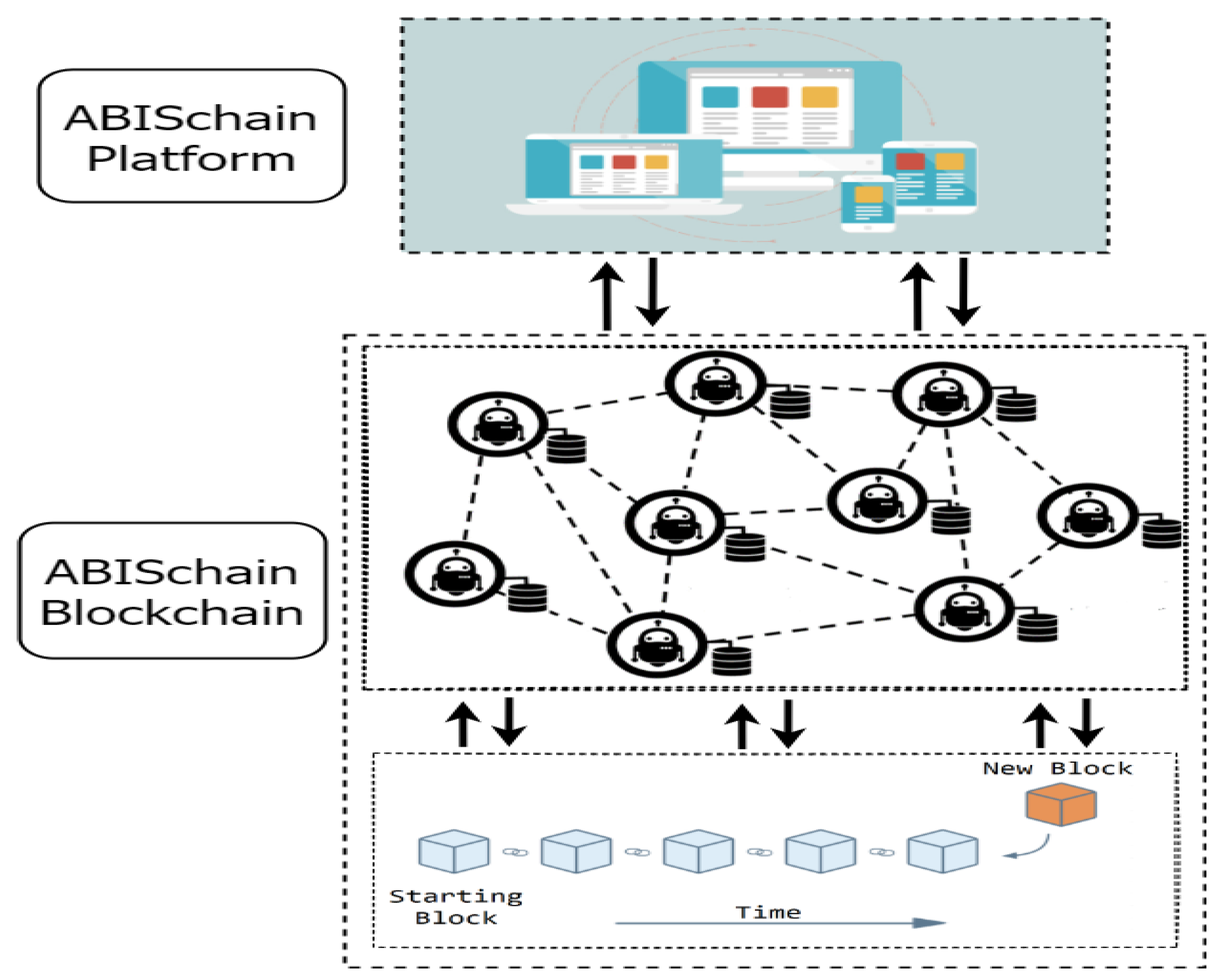
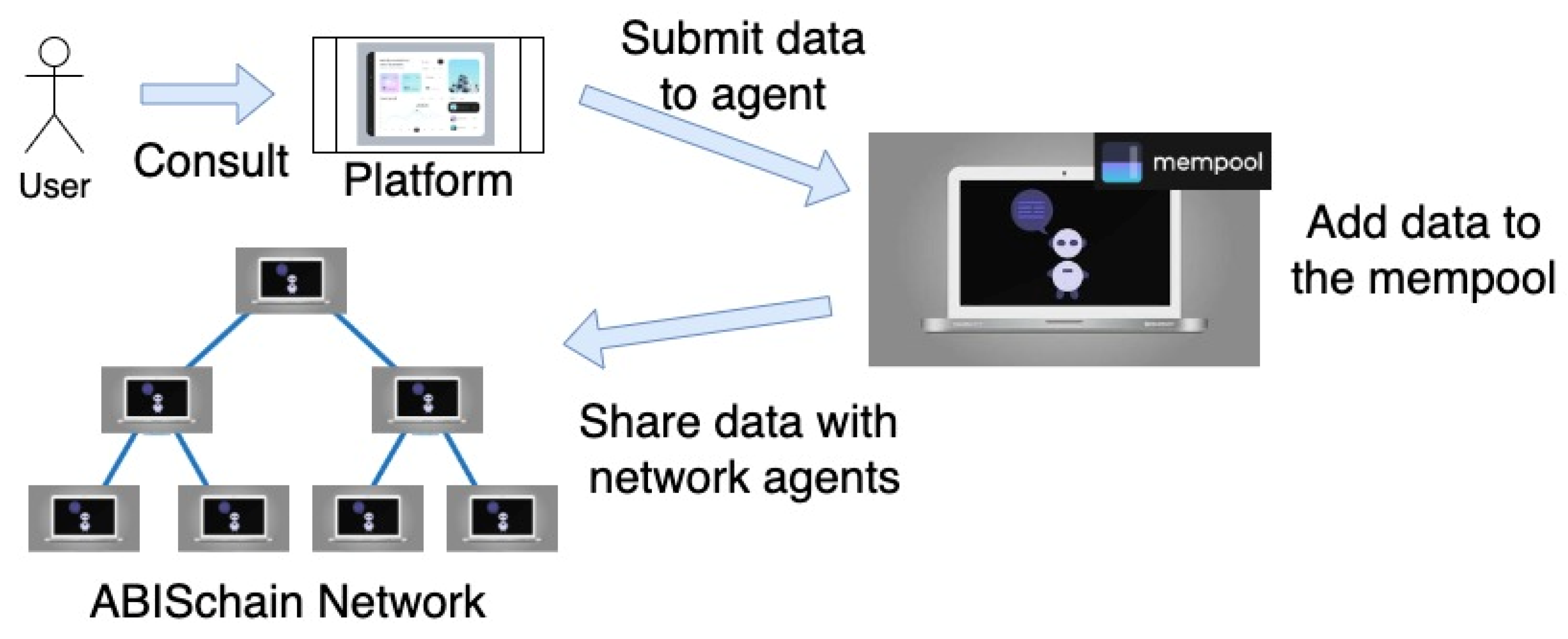
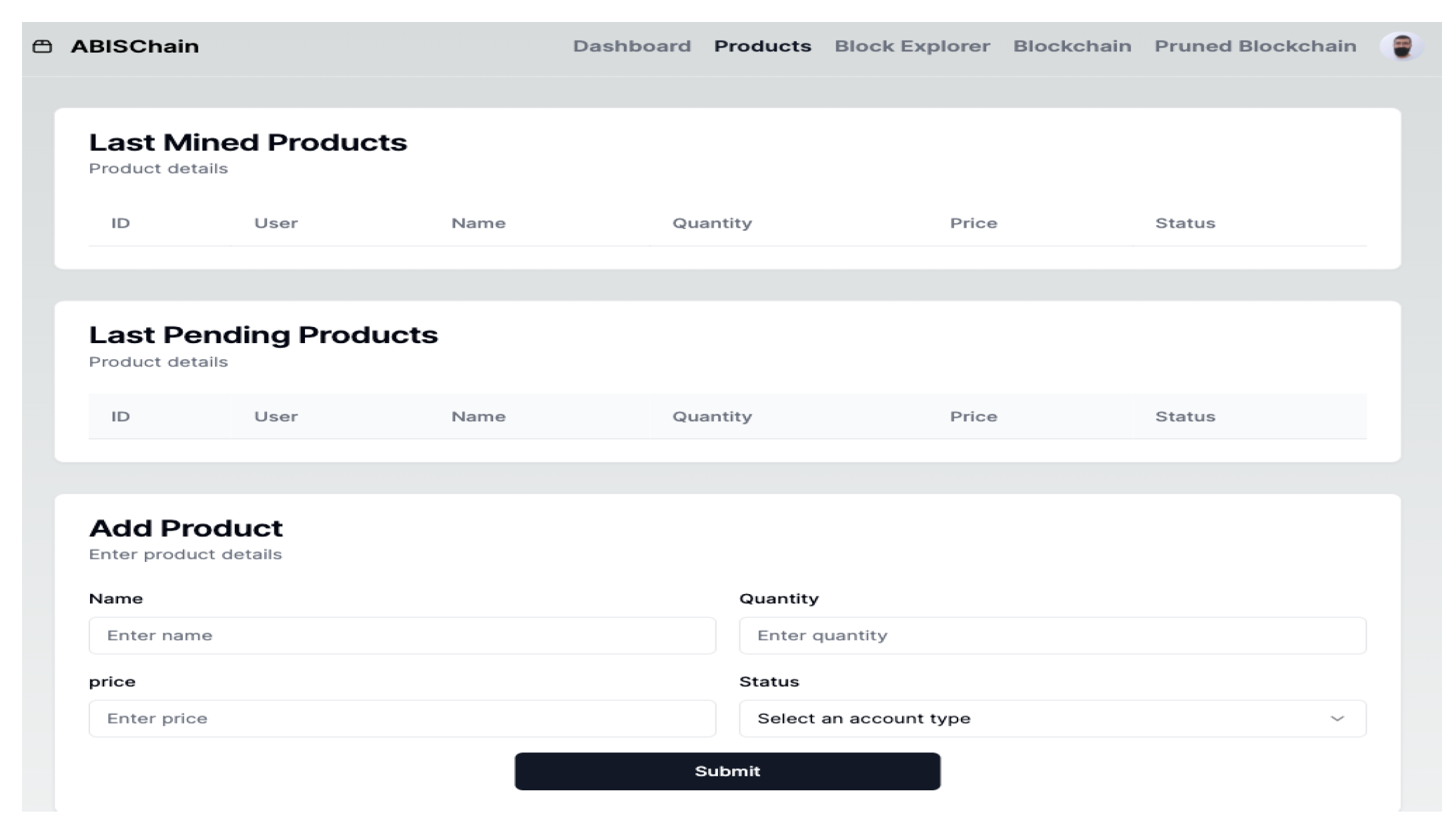
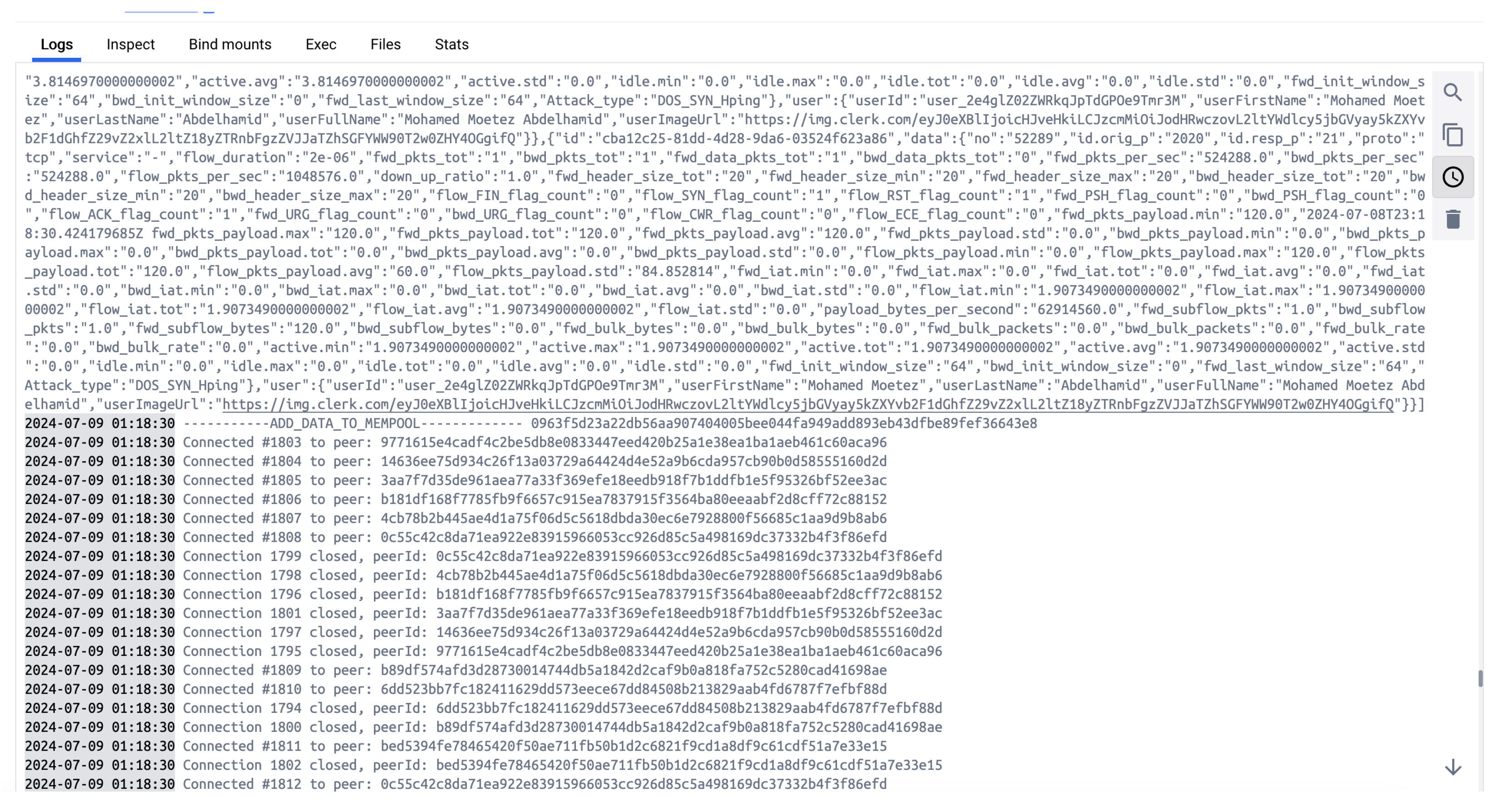

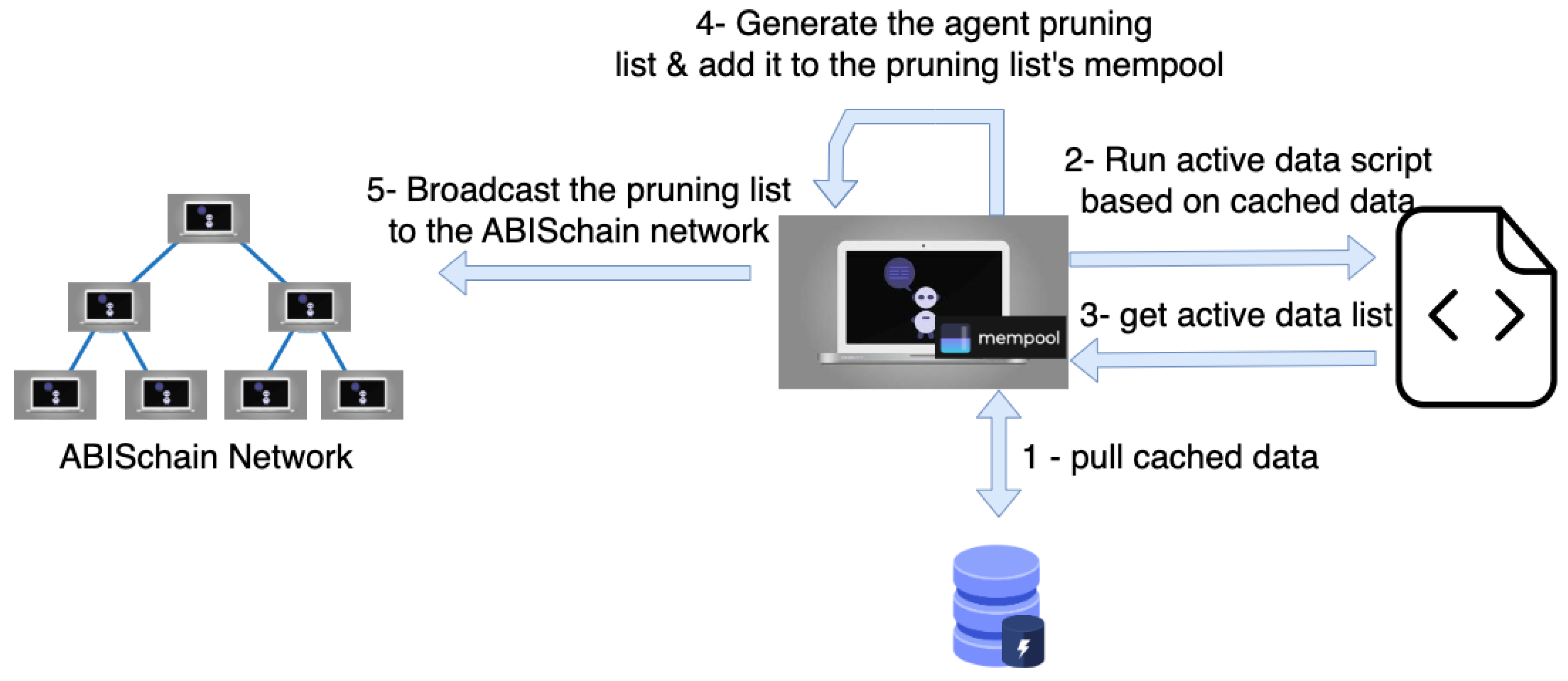

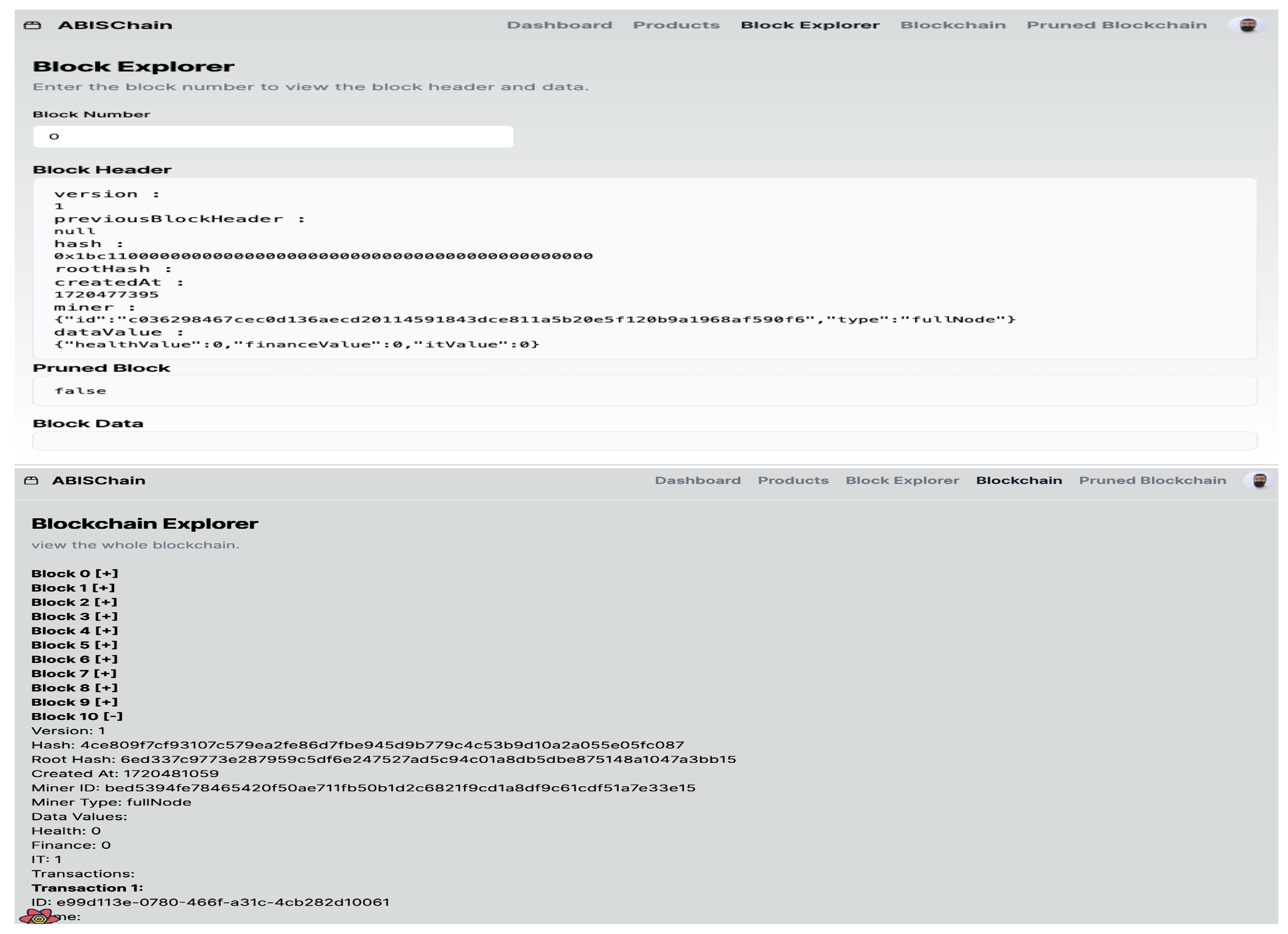





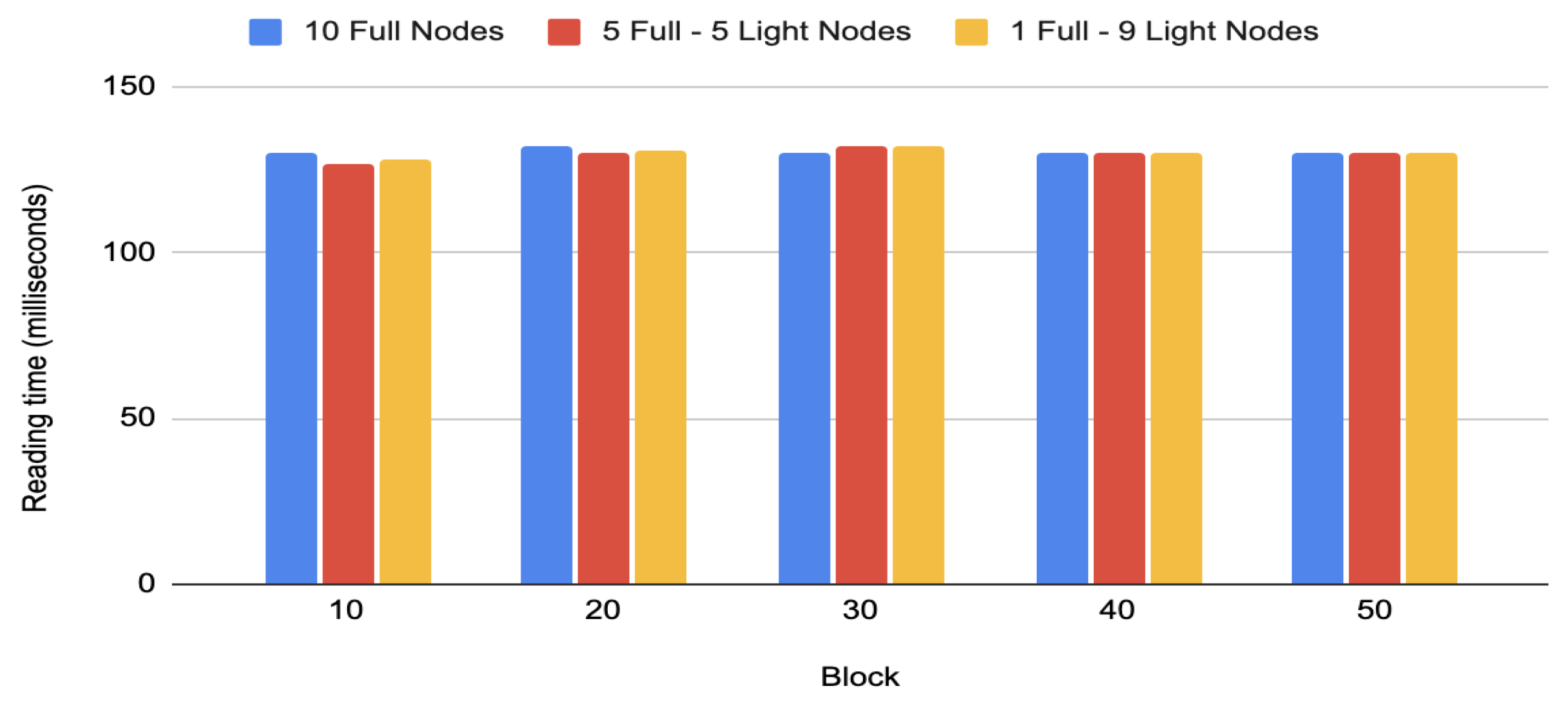

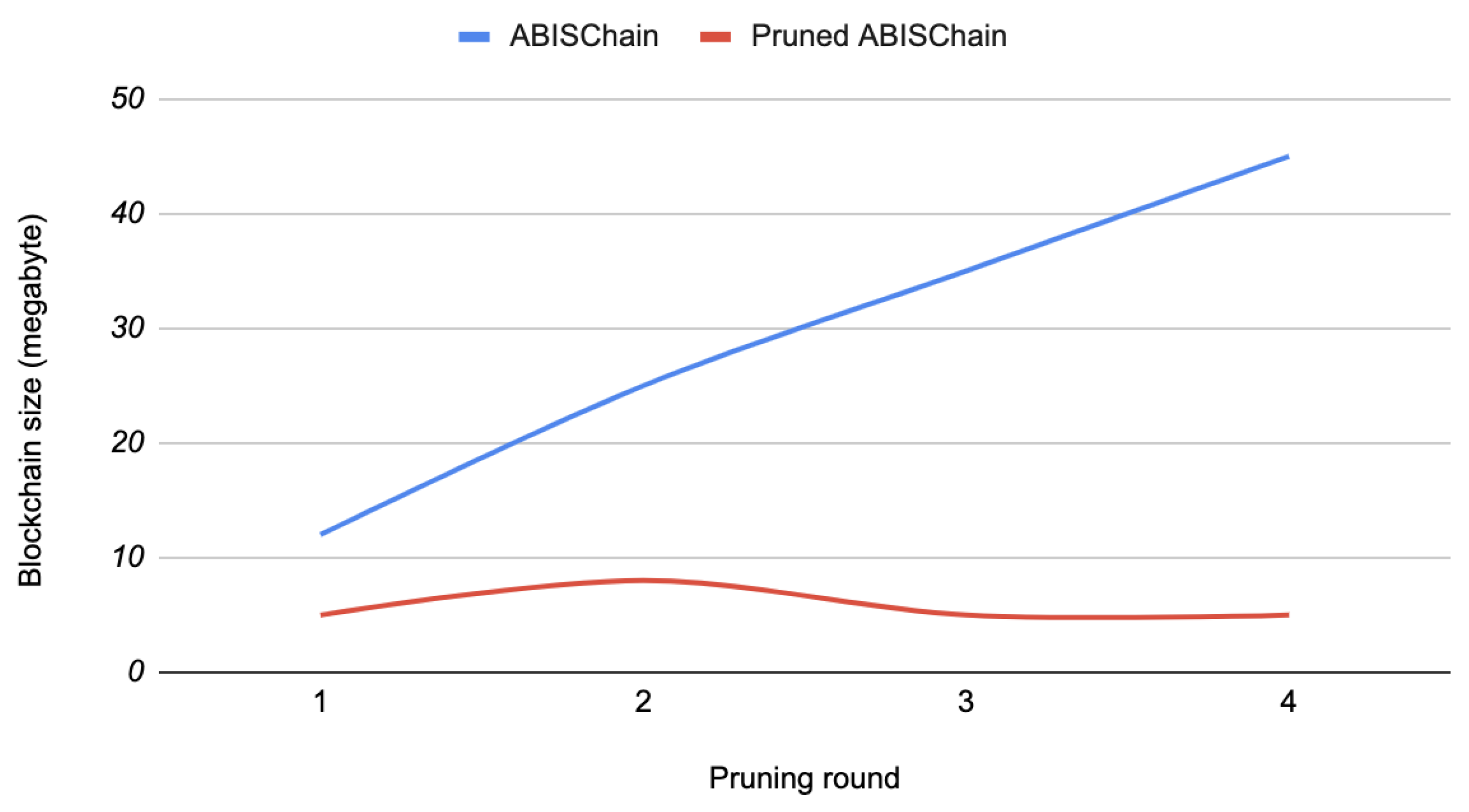
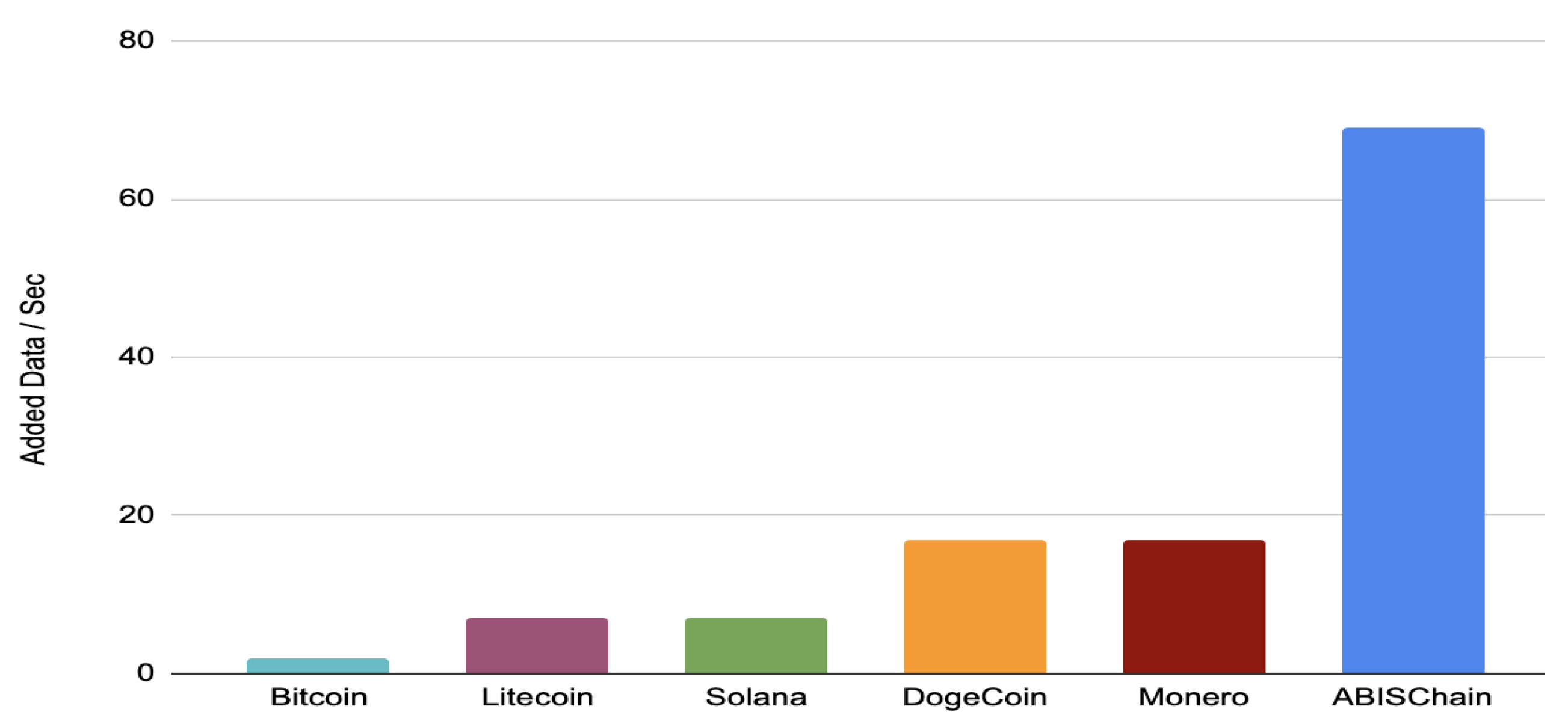
| Challenge | IoT Impact | Blockchain Impact |
|---|---|---|
| Scalability | Overloads systems with vast data. | Slows down transactions with decentralization. |
| Data Management | Inconsistent databases block data flow. | Slow processing due to consensus validation. |
| Security | Susceptible to breaches, lacks strong security. | Strong security but high resource demands. |
| Network Infrastructure | Connectivity issues with dispersed devices. | High costs for continuous synchronization. |
| Resource Efficiency | Struggles with energy under heavy loads. | Resource-heavy, limiting low-power device use. |
| Cost and Fees | High costs for servers and infrastructure. | Transaction fees hinder widespread use. |
| Trust and Transparency | Centralized control, lacking transparency. | Transparent but faces latency and scale issues. |
| Work/Tool or Technique | Sharding | Side-Chain | Core Improvement | Transaction Format | Cloud-Based | Multiple Blockchains Public/Private | Based on Existing Blockchain Solutions (Ethereum, Hyperledger) | Web App |
|---|---|---|---|---|---|---|---|---|
| Shipchain [48] | + | + | + | |||||
| Devery [49] | + | + | ||||||
| Cargox [50] | + | + | ||||||
| CargoCoin [51] | + | + | ||||||
| WaltonChain [52] | + | + | + | |||||
| OriginTrail [53] | + | + | ||||||
| VeChain [54] | + | + | + | + | + | + | + | |
| Ambrosus [68] | + | + | ||||||
| Modum [55] | + | + | ||||||
| Bext360 [56] | + | |||||||
| Tael (WaBI) [57] | + | + | ||||||
| TE-FOOD [58] | + | + | ||||||
| FarmaTrust [59] | + | + | ||||||
| Agrichain [60] | + | + | ||||||
| Blockverify [31] | + | |||||||
| Chronicled [61] | + | + | ||||||
| Everledger [62] | + | + | + | |||||
| Leteane et al. [63] | + | + | + | |||||
| Agri-4-All [64] | + | + | + | |||||
| Table Olives [65] | + | + |
| Consensus | Network | Pros | Cons |
|---|---|---|---|
| Bots now fulfill the duties of miners, with their performance assessed according to their ability to engage effectively with their environment. Involvement = quality of information provided Integrity = The accuracy of the information provided is ensured by randomly selecting highly ranked bots to validate a block. | Machine learning and AI algorithms will allow bots to interact with each other. Bots will adapt to their surroundings on their own. | The consensus mechanism is characterized by its intelligence, adaptability, and dynamic nature. Bots can be hosted on various devices, including desktops, laptops, and smartphones. The scoring process of the bots establishes the trustworthiness of the network and smart applications. | Fails to offer a solution to address the issue of increasing blockchain volume. |
| Blockchain | Bitcoin | Litecoin | Solana | Dogecoin | Monero | ABISChain |
|---|---|---|---|---|---|---|
| Block Size (KB) | 1024 | 1024 | 15–20 | 1024 | 2048 | 1024–2048 |
| Block Time (S) | 600 | 150 | 3 | 60 | 120 | 60–30 |
| Blockchain | Block Size (KB) | Block Time (s) | Data Throughput (KB/sec) | Storage Optimization Technique |
|---|---|---|---|---|
| ABISChain | 1024–2048 | 30–60 | 68 | Pruning |
| Shipchain [48] | 60–100 | 15 | 4.5 | N/A |
| Devery [49] | 60–100 | 15 | 4.5 | N/A |
| CargoX [50] | 60–100 | 15 | 4.5 | N/A |
| OriginTrail [53] | 60–100 | 15 | 4.5 | N/A |
| WaltonChain [52] | 562 | 60 | 9.3 | Sharding |
| VeChain [54] | 50 | 10 | 5 | N/A |
Disclaimer/Publisher’s Note: The statements, opinions and data contained in all publications are solely those of the individual author(s) and contributor(s) and not of MDPI and/or the editor(s). MDPI and/or the editor(s) disclaim responsibility for any injury to people or property resulting from any ideas, methods, instructions or products referred to in the content. |
© 2024 by the authors. Licensee MDPI, Basel, Switzerland. This article is an open access article distributed under the terms and conditions of the Creative Commons Attribution (CC BY) license (https://creativecommons.org/licenses/by/4.0/).
Share and Cite
Abdelhamid, M.M.; Sliman, L.; Ben Djemaa, R. AI-Enhanced Blockchain for Scalable IoT-Based Supply Chain. Logistics 2024, 8, 109. https://doi.org/10.3390/logistics8040109
Abdelhamid MM, Sliman L, Ben Djemaa R. AI-Enhanced Blockchain for Scalable IoT-Based Supply Chain. Logistics. 2024; 8(4):109. https://doi.org/10.3390/logistics8040109
Chicago/Turabian StyleAbdelhamid, Mohamed Moetez, Layth Sliman, and Raoudha Ben Djemaa. 2024. "AI-Enhanced Blockchain for Scalable IoT-Based Supply Chain" Logistics 8, no. 4: 109. https://doi.org/10.3390/logistics8040109
APA StyleAbdelhamid, M. M., Sliman, L., & Ben Djemaa, R. (2024). AI-Enhanced Blockchain for Scalable IoT-Based Supply Chain. Logistics, 8(4), 109. https://doi.org/10.3390/logistics8040109






